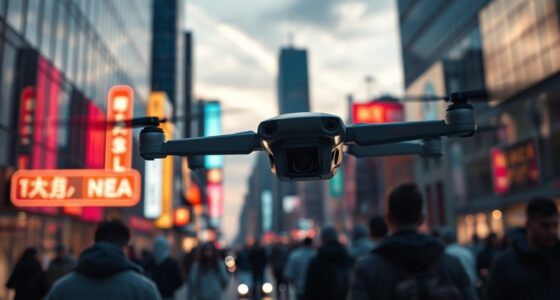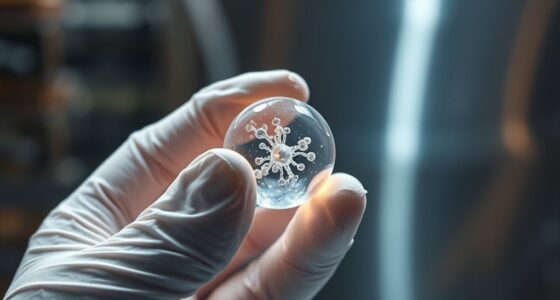Future regulation of nanomachines will focus on balancing innovation with safety and ethics. You’ll see clear standards developed by governments, industry, and scientists to prevent misuse and protect public health. Transparency and stakeholder engagement will be key, ensuring responsible development and building trust. Regulations will stay adaptable, evolving alongside technological progress to address new risks and opportunities. Keep exploring this evolving landscape to understand how responsible oversight guarantees a safe and ethical future for nanomachines.
Key Takeaways
- Developing adaptable, clear regulatory frameworks to balance innovation and safety in nanomachine deployment.
- Establishing international standards and safety protocols for testing, monitoring, and controlling nanomachines.
- Promoting transparency and public engagement to build trust and ensure societal acceptance of nanotechnology.
- Implementing ethical guidelines to prevent misuse and address privacy, consent, and malicious applications.
- Encouraging collaboration among governments, industry, and scientists to continuously update regulations with technological advances.

As nanotechnology advances rapidly, the future regulation of nanomachines becomes an urgent concern. You’re likely aware that these tiny devices have the potential to revolutionize medicine, manufacturing, and environmental management. However, with great power comes great responsibility. Addressing ethical concerns is vital to prevent misuse or unintended harm. As nanomachines become more sophisticated, questions arise about privacy, consent, and the potential for malicious applications. Regulators will need to establish clear boundaries that protect individual rights without stifling innovation. You’ll want to guarantee that ethical considerations keep pace with technological development, fostering trust in nanotechnology’s benefits while minimizing risks. Establishing comprehensive self-regulation frameworks can also help ensure responsible development and deployment. Safety protocols play a pivotal role in shaping future regulations. Since nanomachines operate at a scale invisible to the naked eye, their interactions with biological systems and the environment must be carefully managed. You’ll need rigorous safety standards to prevent unintended consequences, such as toxicity or ecological disruption. Developing all-encompassing safety protocols involves extensive testing, risk assessment, and ongoing monitoring. These measures will help identify potential hazards early and guarantee that nanomachines are deployed responsibly. Governments, industry leaders, and scientists must collaborate to create standardized safety guidelines that are adaptable as the technology evolves. The challenge lies in balancing innovation with caution. You might worry about over-regulation stifling progress, but neglecting safety and ethics could lead to disastrous outcomes. For example, unregulated nanomachines could inadvertently cause health issues or environmental damage, undermining public trust. Hence, future regulations should be flexible enough to accommodate new discoveries while maintaining strict safety and ethical standards. Transparency is key—stakeholders need access to information about how nanomachines are developed, tested, and used. Public engagement and education will be indispensable in shaping policies that are both effective and accepted by society.
Frequently Asked Questions
How Will Nanomachines Impact Global Economic Stability?
Nanomachines could substantially impact your economy by causing market disruption, as their rapid development might shift industries quickly. While they offer potential for innovation, they could also challenge economic resilience, making markets more volatile. You might see new opportunities, but also increased risks, requiring adaptable policies. Ultimately, their influence could reshape global trade and stability, demanding proactive measures to balance benefits and mitigate potential disruptions.
What Are the Ethical Considerations for Autonomous Nanomachine Decision-Making?
Think of autonomous nanomachines as tiny guardians with a moral compass; their decision-making raises serious ethical questions. You must consider who holds moral responsibility if they malfunction or cause harm. Accountability standards become vital, ensuring creators and operators are answerable. Without clear guidelines, you risk losing control over these powerful tools, turning innovation into a Pandora’s box. It’s imperative to set ethical boundaries now to prevent future chaos.
Could Nanomachines Be Used for Malicious Purposes?
Yes, nanomachines could be used for malicious purposes like creating bioweapons or enabling unauthorized surveillance. You might not realize how easily they could be weaponized or used to invade privacy, making them a serious threat. If not properly regulated, malicious actors could exploit nanomachines to cause harm or gather sensitive information. That’s why strict oversight and ethical guidelines are essential to prevent misuse and protect public safety.
How Will International Law Adapt to Nanomachine Regulation?
A stitch in time saves nine. You’ll see international law adapt by strengthening treaties and creating new legal frameworks to regulate nanomachines. Countries will collaborate more, establishing standards and enforcement measures to prevent misuse. As technology advances, your role will be to stay informed and advocate for clear, effective regulations. This proactive approach guarantees nanomachine development benefits humanity while minimizing risks, demonstrating how global cooperation shapes a safer future.
What Are the Long-Term Environmental Effects of Nanomachine Deployment?
You should consider that the long-term environmental effects of nanomachine deployment could include unforeseen ecological impacts and environmental risks. These tiny devices might accumulate in ecosystems, potentially disrupting natural processes or harming wildlife. While nanomachines offer benefits, you need to stay vigilant about their ecological impacts, ensuring proper management and monitoring. Understanding these risks now helps prevent future environmental damage and promotes safer, sustainable nanotechnology use.
Conclusion
As you consider the future of nanomachines, it’s fascinating how regulation might naturally evolve alongside technological advancements. Coincidences like breakthroughs in medicine or environmental cleanup often prompt swift policy changes, shaping a safer, more innovative landscape. While regulation may seem distant now, it’s likely to align unexpectedly with scientific progress, guiding you toward responsible use and endless possibilities. Stay curious—what surprises could regulation and innovation bring next in this tiny, powerful world?








